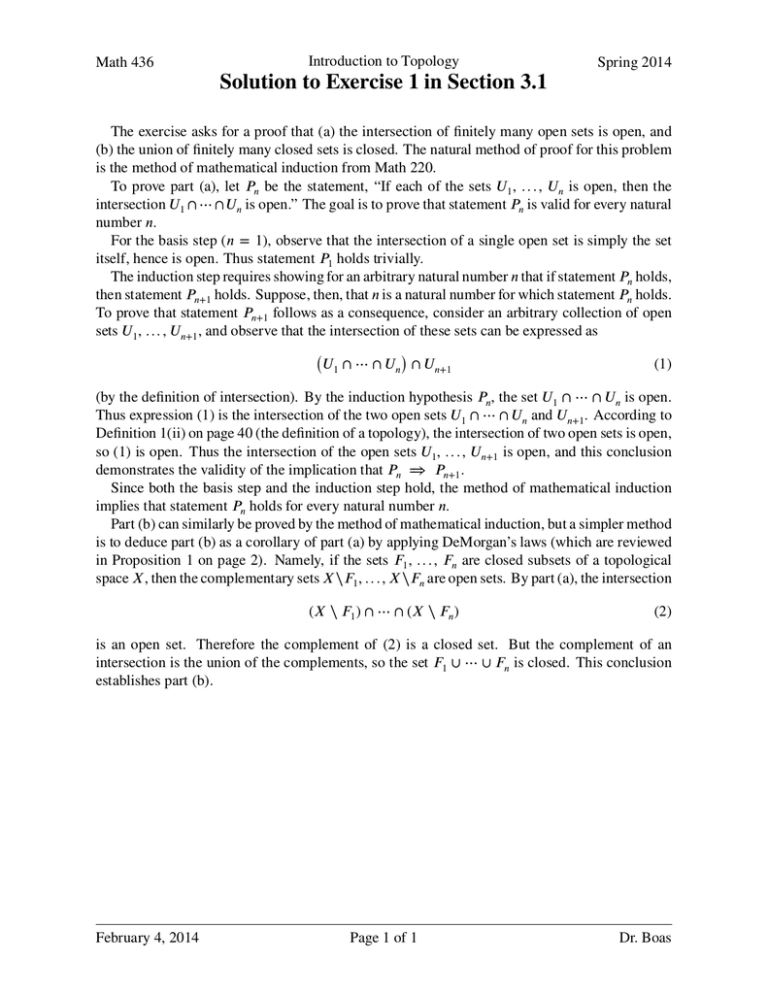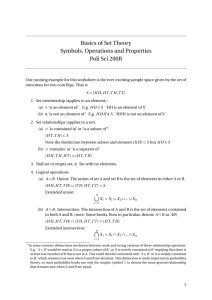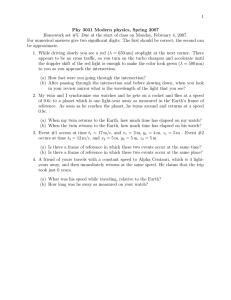Solution to Exercise 1 in Section 3.1
advertisement

Math 436 Introduction to Topology Spring 2014 Solution to Exercise 1 in Section 3.1 The exercise asks for a proof that (a) the intersection of finitely many open sets is open, and (b) the union of finitely many closed sets is closed. The natural method of proof for this problem is the method of mathematical induction from Math 220. To prove part (a), let 𝑃𝑛 be the statement, “If each of the sets 𝑈1 , . . . , 𝑈𝑛 is open, then the intersection 𝑈1 ∩ ⋯ ∩ 𝑈𝑛 is open.” The goal is to prove that statement 𝑃𝑛 is valid for every natural number 𝑛. For the basis step (𝑛 = 1), observe that the intersection of a single open set is simply the set itself, hence is open. Thus statement 𝑃1 holds trivially. The induction step requires showing for an arbitrary natural number 𝑛 that if statement 𝑃𝑛 holds, then statement 𝑃𝑛+1 holds. Suppose, then, that 𝑛 is a natural number for which statement 𝑃𝑛 holds. To prove that statement 𝑃𝑛+1 follows as a consequence, consider an arbitrary collection of open sets 𝑈1 , . . . , 𝑈𝑛+1 , and observe that the intersection of these sets can be expressed as ( ) 𝑈1 ∩ ⋯ ∩ 𝑈𝑛 ∩ 𝑈𝑛+1 (1) (by the definition of intersection). By the induction hypothesis 𝑃𝑛 , the set 𝑈1 ∩ ⋯ ∩ 𝑈𝑛 is open. Thus expression (1) is the intersection of the two open sets 𝑈1 ∩ ⋯ ∩ 𝑈𝑛 and 𝑈𝑛+1 . According to Definition 1(ii) on page 40 (the definition of a topology), the intersection of two open sets is open, so (1) is open. Thus the intersection of the open sets 𝑈1 , . . . , 𝑈𝑛+1 is open, and this conclusion demonstrates the validity of the implication that 𝑃𝑛 ⇐⇒ 𝑃𝑛+1 . Since both the basis step and the induction step hold, the method of mathematical induction implies that statement 𝑃𝑛 holds for every natural number 𝑛. Part (b) can similarly be proved by the method of mathematical induction, but a simpler method is to deduce part (b) as a corollary of part (a) by applying DeMorgan’s laws (which are reviewed in Proposition 1 on page 2). Namely, if the sets 𝐹1 , . . . , 𝐹𝑛 are closed subsets of a topological space 𝑋, then the complementary sets 𝑋⧵𝐹1 , . . . , 𝑋⧵𝐹𝑛 are open sets. By part (a), the intersection (𝑋 ⧵ 𝐹1 ) ∩ ⋯ ∩ (𝑋 ⧵ 𝐹𝑛 ) (2) is an open set. Therefore the complement of (2) is a closed set. But the complement of an intersection is the union of the complements, so the set 𝐹1 ∪ ⋯ ∪ 𝐹𝑛 is closed. This conclusion establishes part (b). February 4, 2014 Page 1 of 1 Dr. Boas




